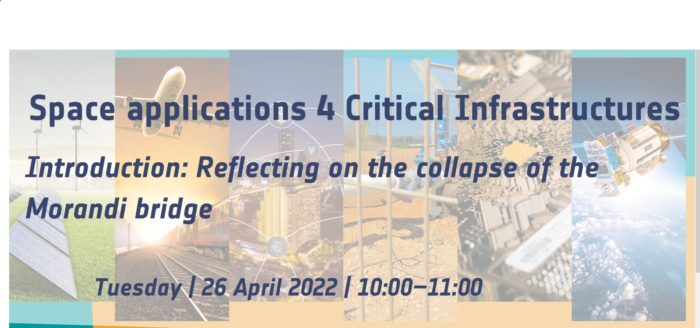The first webinar of “Space for Critical Infrastructure” provided an overview of the proposed directive on the resilience of critical entities and the potential of Earth observation data to boost the resilience of critical infrastructure. The webinar attracted more than 100 registered participants from a diverse audience: public administrations, companies and SMEs, space agencies, space associations, universities, research centres, etc.
An overview of the proposed directive
Max Brandt from the European Commission DG HOME Counter Terrorism Unit, responsible for the critical infrastructure legislation, provided an overview of the proposed directive on the resilience for critical entities. One of the novelties of the proposed directive is that it extends the scope to ten sectors, namely energy, transport, banking, financial market, health, drinking water, wastewater, digital infrastructure, public administration, and space.
Space technology trends and perspectives
With its enlarged scope, the proposed directive will directly apply to space, at least for what concerns the ground-based segment of space infrastructure. But space assets can also serve EU member states to increase the resilience of their critical entities. Michela Corvino, from the European Space Agency (ESA) Earth observation data application division, presented some examples of how Earth observation can be exploited in the context of security of critical infrastructure.
From Earth science missions and the sentinel constellation to meteorology in cooperation with Eumetsat, different Earth observation data sources can help to monitor the status of critical infrastructure such as energy grids, transportation, health infrastructures, etc. One example highlighted was the Rapid Action on Corona Virus and Earth Observation (RACE), an open platform measuring activities in industries, ports, commercial centres, and other areas to monitor the economic and environmental impact of the coronavirus crisis.
You may download her presentation here (link).
Use case of Port-la-Nouvelle
With environmental regulations on one hand and the continuous development of critical infrastructure on the other, operators and authorities face an increasingly difficult balancing test. Aurelie Dehouck, founder of i-Sea, explained how the French Occitanie Region dealt with the risk of turbidity during expansion works in the harbour of Port-la-Nouvelle. The port, strained by climate change and environmental risks, was able to rely on Copernicus satellite imagery to monitor water quality and to rapidly intervene in the event that a turbid plume would spread towards vulnerable areas. For more information find here the use case or watch the video.
Key outcomes and next webinar on the 26th of April 2022
Following these three presentations, an interesting debate took place between the speakers and the audience emphasizing that the proposed directive is not only about the protection of entities providing essential services, but also about making them resilient, i.e. able to resist, absorb, accommodate to and recover from incidents. Member states will need a national strategy for the resilience of their entities. They will need to perform national risk assessments, and will be responsible for identifying critical entities, implementing measures to increase resilience, and will have the obligation to notify incidents. Further, the legislative proposal by the EC has been discussed in the Council and the EP, both have issued their reports and now they are negotiating the final texts. An agreement is expected for this summer.
After three introductory webinars presenting the state of play of the legislative process and the rationale behind the enlargement of the scope of the proposed EU Directive on the resilience of critical entities, a set of thematic webinars will be organised to illustrate operational solutions.
The thematic sessions will cover the different sectors following the enlargement of the scope of the directive and will further demonstrate which kind of satellite-based services EU member states have at their disposal to boost the resilience of their critical entities.
You may now register for the second webinar Introductory webinar reflecting on the collapse of the Morandi bridge which will take place on 26 April 2022, 10.00-11.00 CET.



